August 7th is celebrated as National Handloom Day in India.
But why do we need a National Handloom Day? The country that is home to the largest handloom industry in the world is India. Almost 90% of the world’s handloom is supplied from our country. National Handloom Day is celebrated to commemorate the Swadeshi Movement that was launched on 7th August 1905. Swadeshi Movement was about shunning foreign goods and relying on home-produced goods. Led by Mahatma Gandhi, it was symbolised by millions of Indians using the Charkha spinning wheel to spin yarn. Such handspun yarn was then woven on a handloom to produce textiles for clothing in India. Thus, 7th August was indeed a befitting day to celebrate our ages-old handloom industry.
Contents
The history of handloom in India
It isn’t easy to put a date as to when handloom weaving started in India. However, evidence of handwoven fabrics can be seen from the Harappan Civilization times between 7000 BCE to 600 BCE approximately. The glorious paintings in Ajanta’s caves and carvings on temples reflect many handloom fabrics. One such fabric is Ikat. The Ikat craft tradition is more than 1000 years old and has stood the test of time.
Ikat in India
The word “Ikat” is of Indonesian origin. However, Ikat fabrics are seen in India, Japan, and even countries in Central America. Guatemala known for its Inca civilization also manufactures Ikat woven fabrics. Hence it can not be said that the Ikat weave originated in Indonesia.
Perhaps, like many other craft practices, the Ikat weave developed independently in various parts of the world. India was one such centre. In modern times, Ikat in India is mainly woven in the states of Orissa, Andhra Pradesh, and Gujarat.
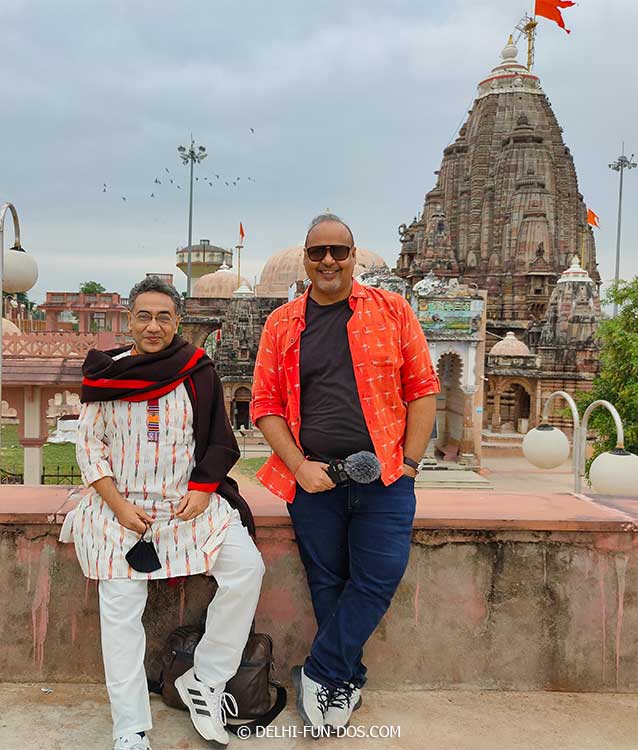
Proudly wearing Ikat shirt and Kurta
Ikat fabrics are used for a host of items today. Saris stitched clothes for men and women, and kurtas are common items. Given the popularity of Ikat, many western brands are now making Ikat fabric shirts.
Bali Jatra
There is another interesting angle about the sharing of Ikat between India and Indonesia. More than 2000 years ago, in about the 3rd century BCE, a group of traders sailed from the shores of Orissa to Bali in Suvarna Dwip, the then name for Indonesia. This event is referred to as Suvarna Yatra or Bali Yatra (Journey to Suvarnadwip or Bali) in history.
Bali Yatra took place on Kartick Purnima in November. This event is still celebrated in Orissa by way of floating colorful paper boats and ships in the sea.
Given the Bali Yatra, cultural and technology exchanges took place between India and various parts of South East Asia such as Sri Lanka, Borneo, Java, Sumatra and so so. It is likely that Ikat fabrics and weaving technology travelled off-shore through such trade exchanges.
The uniqueness of Ikat fabric
There are many types of Ikat fabric. But an Ikat weave is distinguished from other weaves by way of its precise, almost mathematical weaving technique. Ikat uses the resist-dyeing process. Here, based on the final design, parts of the yarn are tied and the remaining yarn is dyed. The dyed yarns are then placed on the loom creating the design. Once the design is formed on the loom using the dyed yarn, the loom is worked to weave the yarns into a fabric. This extremely meticulous process needs time. No wonder Ikat is costlier than many other handwoven fabrics.
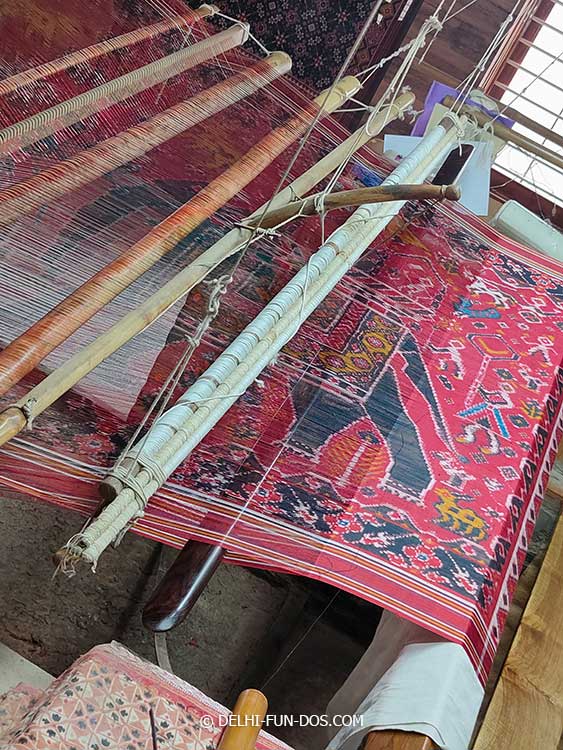
The most common types of Ikat fabric are the single Ikat and double Ikat. In single Ikat, only the yarn used on the warp is dyed. In double Ikat, all yarns that are used on the warp, as well as the weft, are dyed before weaving. Double Ikat, therefore, is a way more painstaking job. A double ikat sari could take a month to weave. Double Ikat is a rarer practice. Patan in Gujarat is well-known for the double Ikat weave Patola.
Double-ikat weaving Patan Patola
Patan in Gujarat is famous for its ancient art of double-ikat weaving Patan Patola. The double Ikat Patola is traced back to the 3rd century Common Era. The rulers of the Chalukya dynasty of Gujarat cherished the Patola weaves. They patronised the Patola weavers who settled in Patan.
The weavers use handspun silk yarn and create geometric motifs depicting flowers, elephants, peacocks, fish, etc. The vibrant colors make it very suitable for Indian festival clothes. The strong double Ikat lasts generations and is considered an heirloom.
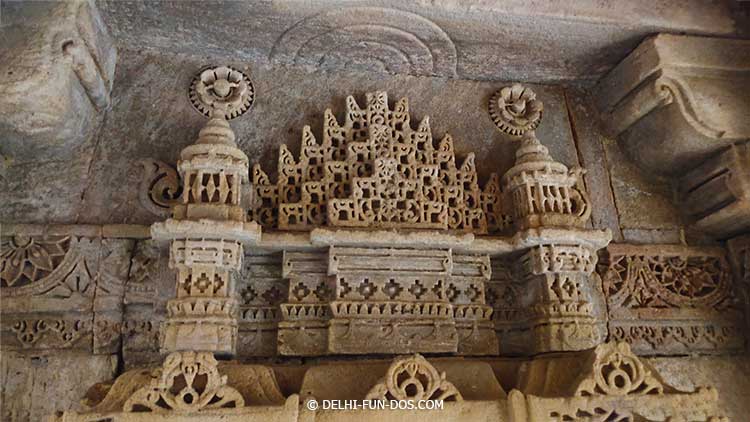
Ikat patterns on the walls of Adlaj ki vav Gujarat
The weave is so deeply ingrained in Gujarat’s cultural fabric that the gorgeous piece of architecture Rani ki Vav. Modhera Sun Temple, Adalaj ki Vav in Ahmedabad, and many other temples have Ikat motifs carved on the walls.
Features of Ikat fabric
Ikat fabric is a classic in its truest sense. This weave has been propagated almost unchanged over generations. What is the uniqueness of Ikat that it is still in demand?
Firstly, the geometric designs in a host of colors make Ikat very attractive as a fabric. It can be used for regular wear as well as for Indian festival clothing. It also demonstrates pride in our heritage. Whenever we wear an Ikat shirt or kurta, we stand apart. The picturesque nature of Ikat designs makes these very suitable for beautiful wall hangings.
Secondly, most varieties of Ikat that are woven in Orissa and Andhra Pradesh are made of cotton. This makes Ikat a very comfortable skin-friendly fabric that is well-suited for Indian weather.
Thirdly, Ikat uses strong yarn for warp and weft. Hence it is extremely durable and can last generations. Moreover, given the strength of the fabric, it is low-maintenance and can be washed, dried, and pressed at home.

Lastly, Ikat is a versatile fabric. Depending on the nature of the yarn that has been used, the durability of Ikat fabric makes it suitable as bedsheets, table cloths, curtains, cushion covers, etc.
Misconceptions about Ikat
Ikat is one of the most popular handloom fabrics across the world. It is, therefore, no surprise that is subjected to spurious copies, fakes, and misconceptions.
Ikat being a catchword in fabrics these days, many prints and machine-made fabrics are passed on as handwoven Ikat to the unsuspecting buyer. Hence, some degree of discernment is necessary to distinguish between a real Ikat and a fake.
Do be aware, that Ikat is not a print, but a weave.
Also sometimes Batik and Ikat are used interchangeably. This is incorrect. Batik is a form of painting or printing on cloth through a wax-resist dyeing process. That means, the parts of a fabric that are to be dyed with a particular color are left bare and the parts that were not to be dyed were covered with wax. Ikat, on the other hand, is a weave. The only connection between Batik art and Ikat weave is that both these forms have traditionally been practiced in Indonesia.
Where to buy Ikat
Genuine Ikat fabrics are available online on select portals. In fact, you may find many other varieties of fabrics on these portals too. If you wish to physically procure Ikat, the best places would be government handloom emporiums operated by Orissa or Andhra Pradesh. These would be the guaranteed sources of authentic Ikat fabric.
Be it National Handloom Day or any other day, we highly endorse hand-woven and handspun fabrics. They are not only cool for Indian weather, but also a definite style statement.

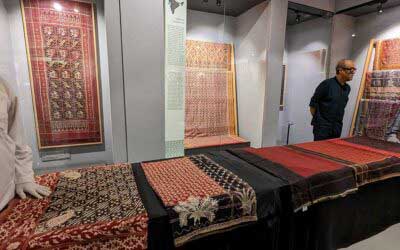
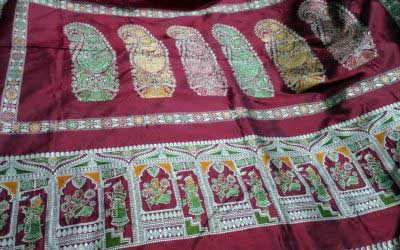
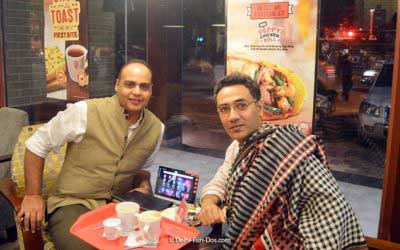
Ikat facinates me. Love the way you have mentioned each and every detail related to it. Misconceptions about it not being print is eye-opening.
Thanks
a well researched article on the topic. I learnt a lot about this beautiful weave through this post. And yes, as rightly pointed out they make a great style statement.
Glad you agree 🙂
The fabric looks amazing & u r looking smart wearing it.
Got to know so much about Ikat fabric.
Thanks 🙂
This is such an informative article. Indian handloom has such rich heritage behind and we have such talented artisans and weavers all across the nation.
So true!
I love Indian prints especially Ikat. Never knew that National Handloom Day exists. And surely it should be celebrated!
The ikat outfits you both are wearing are awesome.
Thanks 🙂